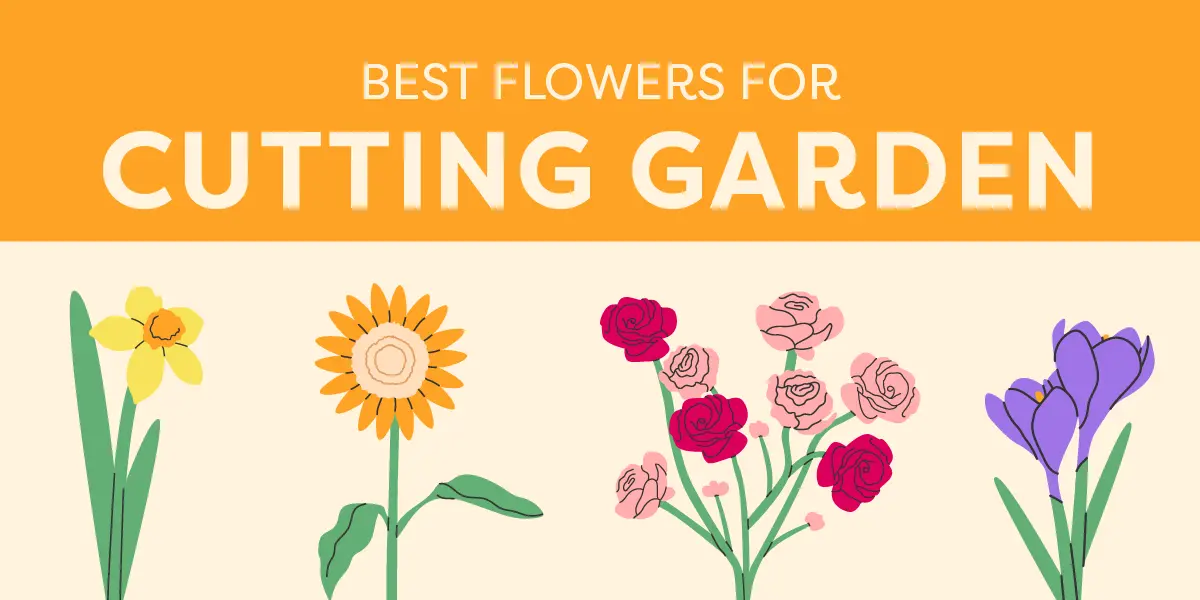When was the last time you saw a floral display that floored you? The Rose Parade on your 8K TV? Or the elaborate floral pageant at your friend’s wedding last month?
The average American wedding spends $2,200 on flowers, typically accounting for 8-10% of the total wedding cost.
That’s a lot of scratch for something that won’t last. Here, we’re referring to the flowers, of course, not the marriage.
Granted, you don’t get married every day unless you’re Elizabeth Taylor, but what if you happen to love flowers? Not just outside, but in all living areas of the house?
Even inexpensive bouquets bought frequently add up quickly, and they may not feature the blooms you enjoy the most.
The answer, dear flower-phile, is a cutting garden in your very own backyard. Bouquets on demand.
What’s a Cut Flower Garden?
A cut flower garden is a section of your yard dedicated to growing flowers for floral arrangements. These gardens contain a variety of blossoming plants, both annuals and perennials, that can be harvested throughout the growing season.
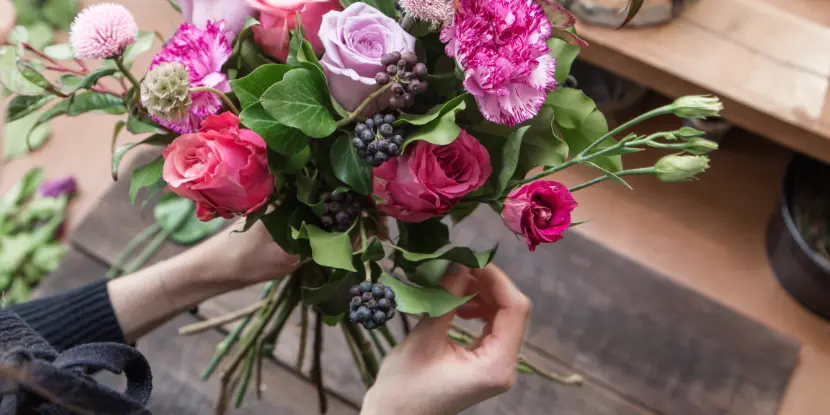
A fresh bouquet from the garden.
Why Grow Your Own Cut Flowers?
- You save money on the cost of flowers and can have beautiful, garden-fresh arrangements whenever you like.
- You have complete control over what you grow and in what quantities. You can choose your favorite flowers and experiment with new varieties.
- Growing your cut flowers means knowing where they come from and how they were grown. It’s a great way to support sustainable gardening practices.
- Your bouquets will last longer since they’re freshly cut and not transported long distances.
The Southern California Advantage
Southern California offers year-round gardening, especially in the most temperate coastal areas.
With our warm, sunny days and mild winters, many flowers flourish here, giving you a nearly endless choice of blooms.
Best Flowers for Your SoCal Cut Flower Garden
1. Roses (Rosa spp.)
Who can resist a rose? Certainly not Shakespeare, even by another name. With a mind-boggling variety of colors and forms, roses are a staple of any cut flower garden.
- Ideal Growing Conditions: Full sun, well-drained soil
- Bloom Time: Spring to fall
- Ideal Temperatures: 60°F (15°C) to 70°F (21°C) for optimal blooming, but many varieties tolerate higher temperatures
- Plant Life: Perennial
- Flower Colors: Too many to list, but popular varieties include ‘Double Delight’ (red and white), ‘Peace’ (yellow and pink), and ‘Iceberg’ (white)
2. Dahlias (Dahlia spp.)
Prepare to be dazzled. Dahlias have intricate, showy, brilliant blooms that can last for days in a vase, making them a favorite with cut flower enthusiasts.
- Ideal Growing Conditions: Full sun, well-drained soil
- Bloom Time: Summer to fall
- Ideal Temperatures: Between 60°F (15°C) and 80°F (27°C); they don’t tolerate frost
- Plant Life: Perennial, but tubers need to be lifted and stored in colder regions
- Flower Colors: Almost every color except blue
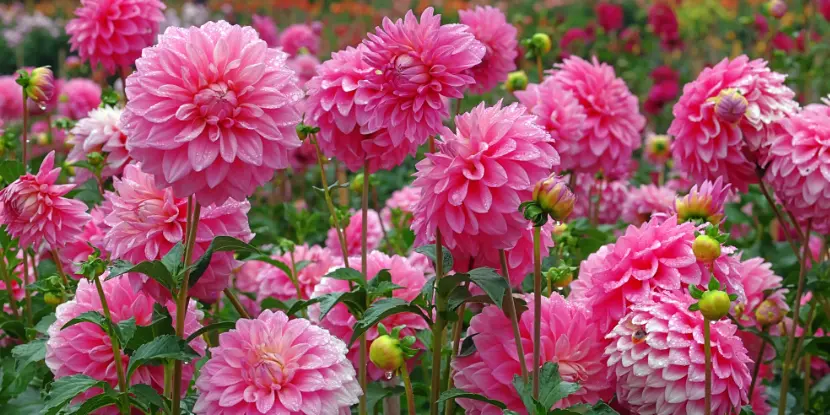
Pink dahlias in a garden.
3. Sunflowers (Helianthus annuus)
Sunflowers bring a cheerful, sunny vibe to your bouquet. They’re easy to grow and make a bold statement. As a bonus, they produce tasty and nutritious seeds! Baseball couldn’t survive without them.
- Ideal Growing Conditions: Full sun, well-drained soil
- Bloom Time: Summer to fall
- Ideal Temperatures: Between 70°F (21°C) and 78°F (26°C)
- Plant Life: Annual
- Flower Colors: Bright yellow, but new varieties include red and orange shades
4. Zinnias (Zinnia elegans)
Zinnias are the workhorses of the cut flower garden. They bloom profusely and grow in various colors and forms, from dainty single blooms to full-petaled showstoppers. Plus, they’re easy to cultivate from seed.
- Ideal Growing Conditions: Full sun, well-drained soil
- Bloom Time: Summer to fall
- Ideal Temperatures: Between 75°F (24°C) and 85°F (29°C), but can tolerate hotter temperatures
- Plant Life: Annual
- Flower Colors: Wide range, including pink, orange, red, and purple
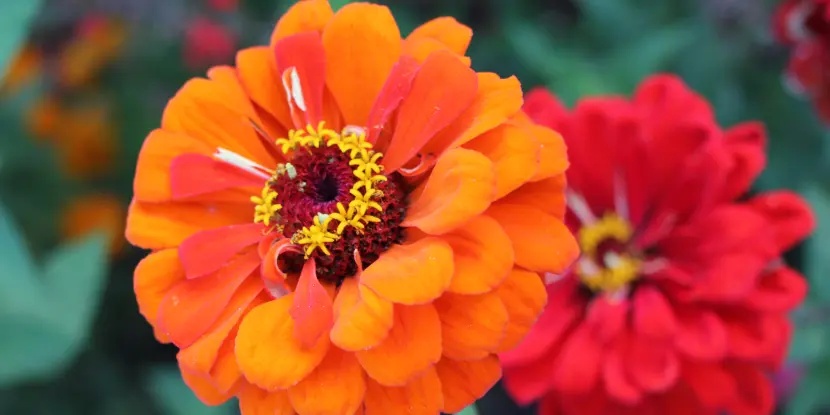
Brilliant zinnia blooms.
5. Gladiolus (Gladiolus spp.)
With their tall spikes of brilliant blooms, gladioli make a dramatic statement. They can be planted at different times throughout the season for continuous blooming.
- Ideal Growing Conditions: Full sun, well-drained soil
- Bloom Time: Summer to fall
- Ideal Temperatures: Between 70°F (21°C) and 85°F (29°C)
- Plant Life: Perennial, but corms need to be lifted and stored in colder regions
- Flower Colors: Wide range, including bi-colors and speckled blooms.
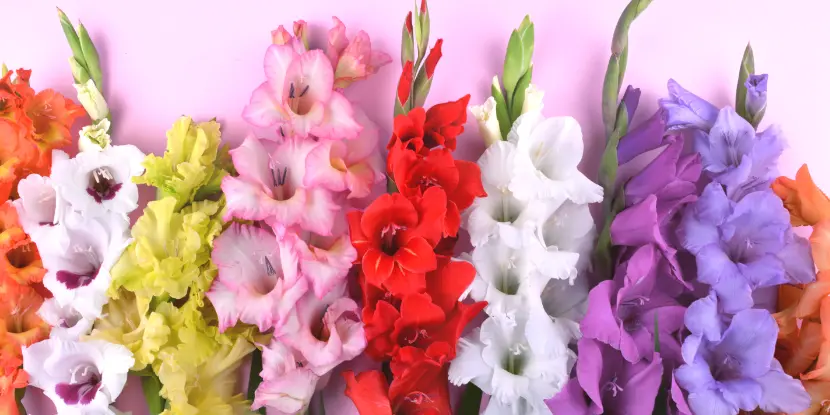
The spiking configuration of gladiolus flowers.
6. Cosmos (Cosmos bipinnatus)
These heat-loving flowers are native to Mexico, making them well-suited to warm Southern California. Their dainty blossoms are perfect for filling out bouquets.
- Ideal Growing Conditions: Full sun, well-drained soil
- Bloom Time: Summer to fall
- Ideal Temperatures: Between 70°F (21°C) and 85°F (29°C)
- Plant Life: Annual
- Flower Colors: Pink, purple, white, and red.
7. Snapdragons (Antirrhinum majus)
Snapdragon flowers grow in a dramatic spiked arrangement and bloom in almost every color imaginable.
- Ideal Growing Conditions: Full sun to partial shade, well-drained soil
- Bloom Time: Spring to fall
- Ideal Temperatures: Between 55°F (13°C) and 65°F (18°C)
- Plant Life: Annual, but may reseed in mild climates
- Flower Colors: Wide range, including pastel shades.
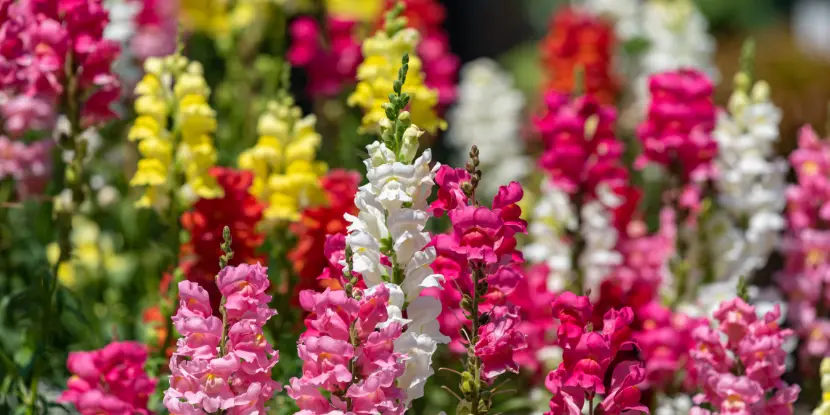
Snapdragons growing in a field.
8. Lavender (Lavandula spp.)
Lavender brings a soft, lovely fragrance to your bouquets. Its calming scent makes it a natural for relaxing spaces like bedrooms and bathrooms.
- Ideal Growing Conditions: Full sun, well-drained soil
- Bloom Time: Late spring to early summer
- Ideal Temperatures: Between 70°F (21°C) and 80°F (27°C)
- Plant Life: Perennial
- Flower Colors: Purple, pink, white, and blue.
9. Lisianthus (Eustoma grandiflorum)
With its long-lasting, rose-like blossoms, Lisianthus is a stunning addition to any garden or bouquet.
- Ideal Growing Conditions: Full sun, well-drained soil
- Bloom Time: Summer to fall
- Ideal Temperatures: Between 70°F (21°C) and 80°F (27°C)
- Plant Life: Annual or short-lived perennial
- Flower Colors: Usually in shades of blue, purple, and pink.
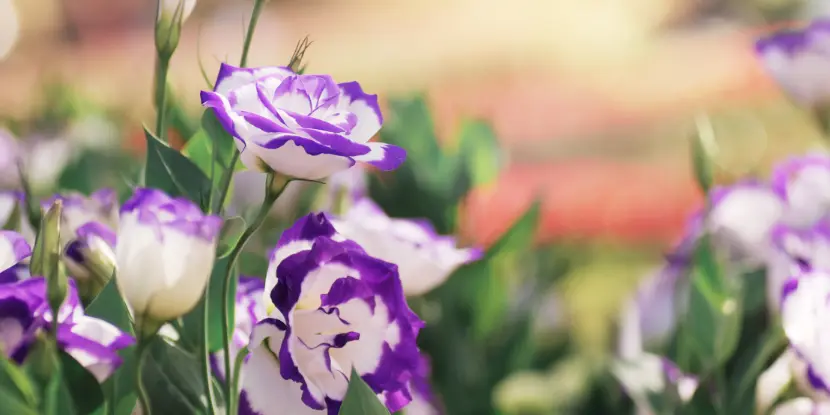
Lisianthus or prairie gentian Eustoma flowers in nature’s beauty.
10. Marigolds (Tagetes spp.)
Marigolds produce vibrant, golden blooms with a strong scent. They’re known for their pest-repelling properties and are excellent companion plants for many vegetables.
- Ideal Growing Conditions: Full sun, well-drained soil
- Bloom Time: Summer to fall
- Ideal Temperatures: Between 75°F (24°C) and 85°F (29°C)
- Plant Life: Annual
- Flower Colors: Shades of orange, yellow, and red.
11. Larkspur (Consolida ajacis)
Larkspur’s tall spikes of blooms lend drama and texture to a floral arrangement.
- Ideal Growing Conditions: Full sun, well-drained soil
- Bloom Time: Spring to early summer
- Ideal Temperatures: Between 60°F (15°C) and 75°F (24°C)
- Plant Life: Annual
- Flower Colors: Shades of blue, pink, white, and purple.
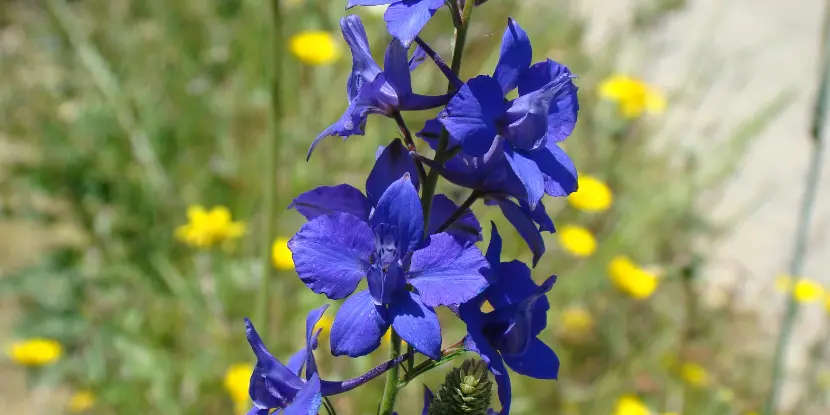
Close-up of Rocket Larkspur (Consolida ajacis).
12. Gloriosa Daisy (Rudbeckia hirta)
Gloriosa daisies are a type of black-eyed Susan that produces large, showy blooms. They make superb accent flowers in arrangements.
- Ideal Growing Conditions: Full sun to partial shade, well-drained soil
- Bloom Time: Summer to fall
- Ideal Temperatures: Between 65°F (18°C) and 85°F (29°C)
- Plant Life: Perennial, but may be short-lived
- Flower Colors: Yellow or orange with dark centers.
13. Chrysanthemums (Chrysanthemum spp.)
Chrysanthemums, or “mum,” are a fall favorite because of their showy blooms. They come in a range of colors and sizes.
- Ideal Growing Conditions: Full sun to partial shade, well-drained soil
- Bloom Time: Summer to fall
- Ideal Temperatures: Between 65°F (18°C) and 75°F (24°C)
- Plant Life: Perennial, but may be short-lived
- Flower Colors: Wide range of colors including yellow, orange, red, pink,
14. Ranunculus (Ranunculus asiaticus)
Ranunculus, or “buttercups,” produce delicate, multi-petaled blooms.
- Ideal Growing Conditions: Full sun to partial shade, well-drained soil
- Bloom Time: Spring
- Ideal Temperatures: Between 55°F (13°C) and 65°F (18°C)
- Plant Life: Perennial in warmer climates but often grown as annuals
- Flower Colors: Wide range including white, yellow, pink, red and purple
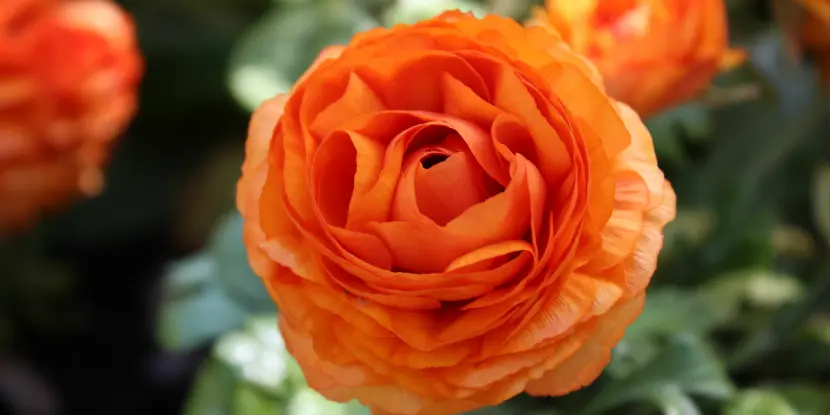
Close-up of an orange Persian buttercup flower in the garden.
15. Stock Flower (Matthiola incana)
Stock flowers are prized for their spicy-sweet fragrance and full, clustered blooms. They’re a staple in fragrant bouquets.
- Ideal Growing Conditions: Full sun to partial shade, well-drained soil
- Bloom Time: Spring to summer
- Ideal Temperatures: Between 55°F (13°C) and 70°F (21°C)
- Plant Life: Annual or biennial
- Flower Colors: White, pink, purple, and yellow.
16. Amaranth (Amaranthus spp.)
Amaranth bears striking, cascading or spear-like blooms in rich reds, purples, and greens.
- Ideal Growing Conditions: Full sun, well-drained soil
- Bloom Time: Summer to fall
- Ideal Temperatures: Between 65°F (18°C) and 80°F (27°C)
- Plant Life: Annual
- Flower Colors: Various shades of red, purple, or green.
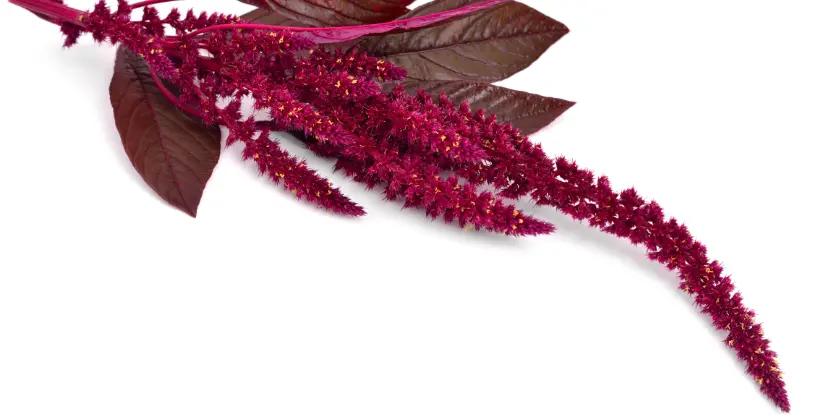
The distinctive flowering spikes of amaranth.
17. Hydrangeas (Hydrangea spp.)
Hydrangeas produce large, ball-like clusters of flowers perfect for voluminous bouquets. Their blooms can change color depending on the acidity of the soil.
- Ideal Growing Conditions: Partial sun to partial shade, well-drained soil
- Bloom Time: Summer to fall
- Ideal Temperatures: Between 60°F (15°C) and 70°F (21°C)
- Plant Life: Perennial in warmer climates but may need protection from cold temperatures
- Flower Colors: Shades of blue, pink, purple, and white.
18. Phlox (Phlox paniculata)
Phlox yields an abundance of tiny, fragrant blossoms in clusters on tall stems.
- Ideal Growing Conditions: Full sun to partial shade, well-drained soil
- Bloom Time: Summer to fall
- Ideal Temperatures: Between 65°F (18°C) and 75°F (24°C)
- Plant Life: Perennial
- Flower Colors: Wide range including pink, purple, white, and red.
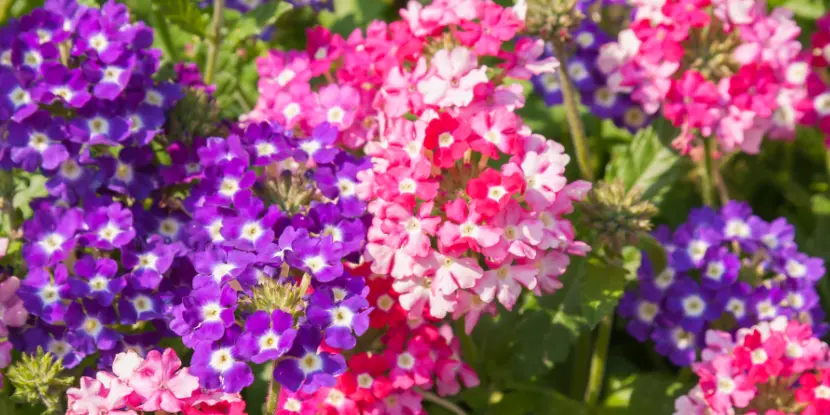
The Phlox paniculata or Garden Phlox in bloom.
19. Pansies (Viola tricolor)
Pansies bringing a cheerful touch to a bouquet with their bright colors and distinctive “faces.” Their color diversity makes them easy to match them with other flowers.
- Ideal Growing Conditions: Full sun to partial shade, well-drained soil
- Bloom Time: Fall to early spring
- Ideal Temperatures: Between 45°F (7°C) and 65°F (18°C)
- Plant Life: Annual or perennial depending on climate
- Flower Colors: Wide range including purple, yellow, orange, pink, and white.
20. Anemones (Anemone coronaria)
Anemones have delicate, cup-shaped flowers in a striking range of colors. They make beautiful additions to bouquets and are often used in wedding arrangements.
- Ideal Growing Conditions: Full sun to partial shade, well-drained soil
- Bloom Time: Spring to summer
- Ideal Temperatures: Between 45°F (7°C) and 65°F (18°C)
- Plant Life: Perennial in warmer climates but typically grown as annuals
- Flower Colors: White, pink, red, purple, blue, and more.
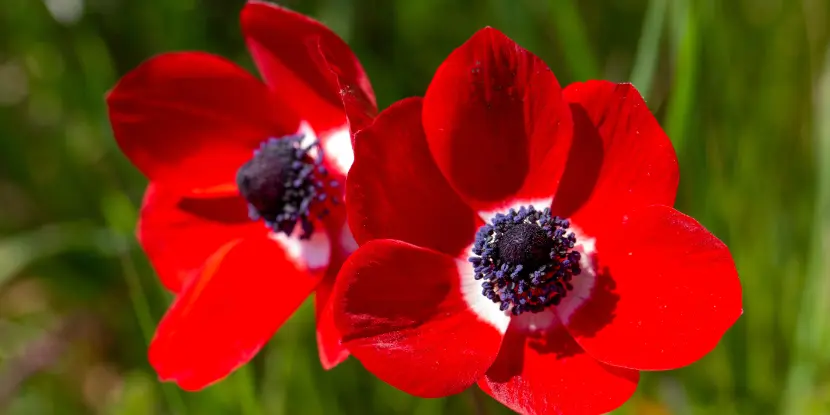
Anemone coronaria growing wild in a field.
21. California Poppies (Eschscholzia californica)
The California state flower bears delicate, papery blooms in shades of orange and yellow.
- Ideal Growing Conditions: Full sun, well-drained soil
- Bloom Time: Spring to early summer
- Ideal Temperatures: Between 60°F (15°C) and 85°F (29°C)
- Plant Life: Annual
- Flower Colors: Shades of orange, yellow, and cream.
22. Hollyhocks (Alcea rosea)
Hollyhocks are tall and majestic, with towering spires of blooms in rich colors.
- Ideal Growing Conditions: Full sun to partial shade, well-drained soil
- Bloom Time: Summer
- Ideal Temperatures: Between 60°F (15°C) and 75°F (24°C)
- Plant Life: Biennial or short-lived perennial
- Flower Colors: Wide range including pink, purple, yellow, red, and white.
23. Salvia (Salvia spp.)
Salvias are beloved for their spikes of vibrant blue, purple, or red flowers and their aromatic foliage.
- Ideal Growing Conditions: Full sun, well-drained soil
- Bloom Time: Summer to fall
- Ideal Temperatures: Between 60°F (15°C) and 80°F (27°C)
- Plant Life: Perennial in warmer climates but often grown as annuals
- Flower Colors: Blue, purple, red, pink, or white.
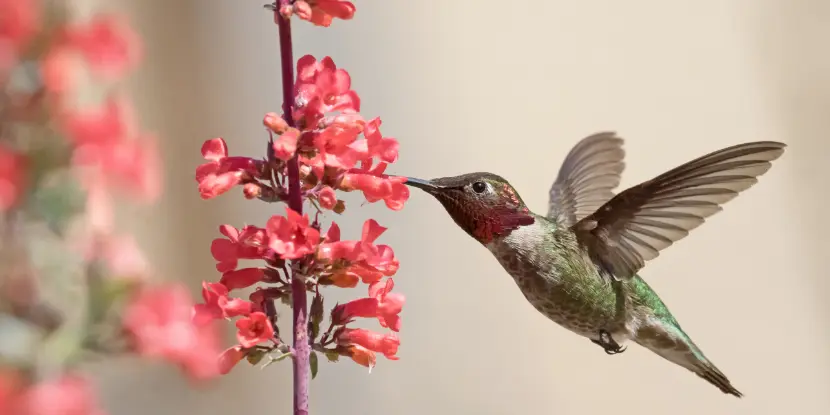
An Allen’s Hummingbird feeding from red salvia.
24. Anise Hyssop (Agastache foeniculum)
This native plant produces dense spikes of tubular, lavender-blue flowers that attract pollinators in volume. It also has a pleasant anise or licorice scent.
- Ideal Growing Conditions: Full sun to partial shade, well-drained soil
- Bloom Time: Summer to fall
- Ideal Temperatures: Between 65°F (18°C) and 75°F (24°C)
- Plant Life: Perennial in warmer climates but often grown as annuals
- Flower Colors: Lavender-blue or purple.
25. Irises (Iris spp.)
Irises stand out for their striking, sword-like leaves and large, showy blooms in various colors.
- Ideal Growing Conditions: Full sun to partial shade, well-drained soil
- Bloom Time: Spring to early summer
- Ideal Temperatures: Between 55°F (13°C) and 70°F (21°C)
- Plant Life: Perennial
- Flower Colors: Wide range including purple, blue, yellow, white, and more.
Tips for Growing a Cut Flower Garden
Follow these handy tips for a thriving garden:
- Most cut flowers need full. Pick a spot that gets at least six hours of sunlight daily.
- Well-drained soil is crucial. Amend your garden soil with compost or organic matter to improve drainage and fertility.
- Keep the soil consistently moist, especially during dry spells. Drip irrigation is the best way to provide consistent moisture without wetting the foliage.
- Use a balanced fertilizer to encourage healthy growth and abundant blooms. Follow the recommendations on the fertilizer packaging.
- Deadheading (removing) spent flowers encourages plants to produce more blooms and keeps your garden tidy.
- Some flowers, like dahlias and gladiolus, may need staking to prevent them from toppling over.
- Watch for common garden pests and diseases. Early detection and treatment are critical for plant health.
FAQs: Maintaining a Cutting Garden
Q: What are the best times to plant cut flowers in Southern California?
Spring and fall are the best times to plant cut flowers in Southern California. These seasons offer mild temperatures and optimal growing conditions.
Q: How often should I water my cut flower garden?
Most cut flowers require regular watering, especially during hot, dry periods. Aim to keep the soil consistently moist but not soggy. Watering deeply once or twice a week is usually sufficient.
Q: Can I grow cut flowers in containers?
Many cut flowers can be grown in containers. Just ensure your pots have good drainage and you water them more often. Containers tend to dry out faster than garden beds.
Q: How do I extend the vase life of my cut flowers?
Cut them early in the morning when they’re well-hydrated, strip off any leaves submerged in water, and change the water every couple of days. Adding a floral preservative to the water can also help.
Q: How can I control weeds in my cut flower garden?
Mulching is one of the most effective ways to control weeds. Apply a layer of organic mulch, like straw or wood chips, around your plants to suppress weed growth and retain soil moisture. Regularly hand-pulling weeds also keeps them from taking over your garden.
Q: What can I do to attract pollinators to my flower garden?
Plant a variety of flowers that bloom at different times throughout the growing season to provide a consistent food source. Native plants are particularly effective at attracting local pollinators. Avoid using pesticides that can harm beneficial insects.
Q: How do I know when my flowers are ready to be cut for arrangements?
Cut them when they’re just starting to open. This is when they’ll last the longest in a vase. Use sharp pruners to make a clean cut, and immediately place the cut flowers in a bucket of water to keep them hydrated.
Q: Is there a particular angle that’s best for cutting?
We recommend cutting flowers at a 45-degree angle. This slant cut increases the surface area at the end of the stem, allowing the flower to absorb more water. It also prevents the stem from sitting flat against the bottom of the vase, which can block water uptake. Use sharp, clean pruners or scissors to minimize damage to the stem and reduce the risk of bacterial growth that can shorten the vase life of your flowers.

